Trombone Glissando Chart — Essential Technique for Straight and F-Attachment Trombones
Original price was: $0.65.$0.00Current price is: $0.00.
Unlock the smooth, sliding magic of trombone glissandos with our comprehensive guide. Perfect for beginners and pros alike, this post features detailed sheet music, expert tips, and exercises for both straight and F-attachment trombones. Elevate your playing and add that signature trombone flair to your performances!
Description
The trombone glissando is a unique and iconic technique that defines the instrument’s character. It’s that smooth, sliding sound that makes the trombone TRULY special. This exercise helps develop precise slide control and pitch awareness for trombone players of all levels.
A glissando (or “gliss” for short) is a continuous slide between two notes. On the trombone, you achieve it by moving the slide while maintaining a steady airflow. This technique opens up a world of expressive possibilities — from jazzy effects to classical portamentos.
Whether you’re just starting out or looking to refine your skills, practicing glissandos WILL improve your overall trombone playing. Let’s dive into the nitty-gritty of this essential trombone technique!!

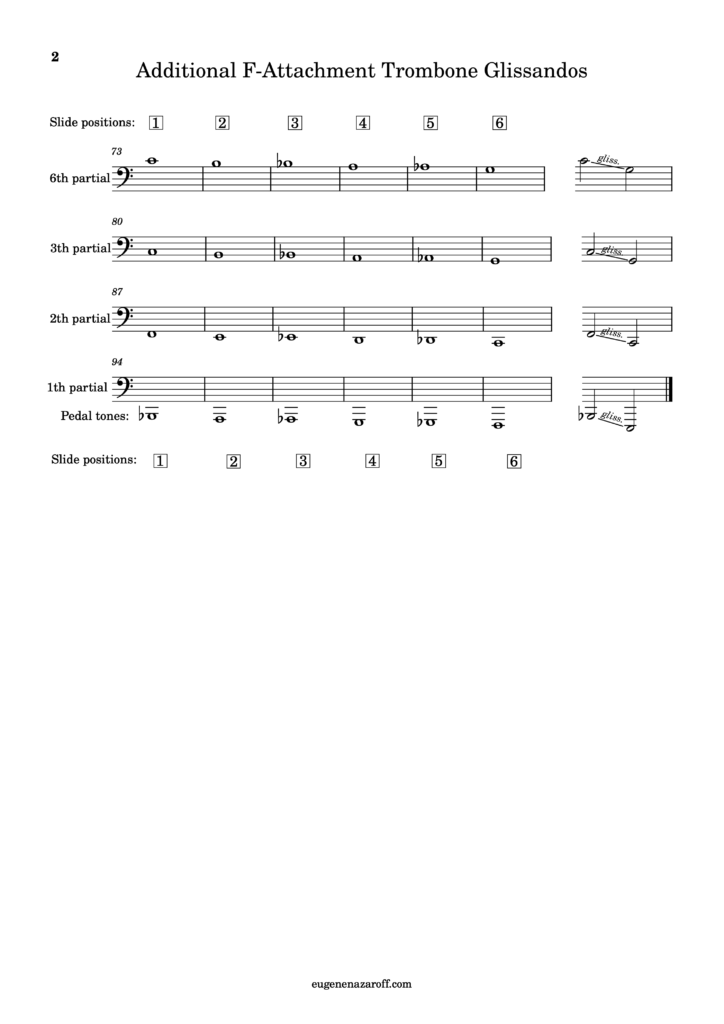
Trombone Glissando Chart — Sheet Music Overview
This comprehensive trombone glissando chart provides a visual roadmap for mastering this technique. It covers:
- Slide positions (1-7)
- Partials (1st through 9th)
- Notes achievable in each position
- Glissando possibilities between positions
The chart is organized by partials, showing the available notes and glissando ranges for both standard and F-attachment trombones. (It’s like a cheat sheet for your slide, folks!)
Key features:
- Time signature: N/A (exercise-based)
- Key: Various (covers multiple harmonic series)
- Special notation: Glissando lines between achievable notes
## Step-by-Step Breakdown of the Exercise
- **Understand the harmonic series**: Each slide position produces a specific harmonic series. Familiarize yourself with these notes.
- **Start with simple glissandos**: Begin with adjacent positions (e.g., 1st to 2nd) within the same partial.
- **Practice slow, controlled movements**: Maintain a steady airstream while smoothly moving the slide.
- **Expand your range**: Gradually work on glissandos between wider intervals and across partials.
- **Incorporate the F-attachment**: If you have an F-attachment, explore the additional glissando possibilities it offers.
- **Experiment with different speeds**: Try slow, dramatic glissandos and quick, “rip” effects.
- **Focus on intonation**: Aim to hit the target notes accurately at the beginning and end of each glissando.
- **Add musical context**: Practice incorporating glissandos into scales, arpeggios, and simple melodies.
Remember, smooth and controlled movements are key. DON’T rush it — slow and steady wins the glissando race! (Rome wasn’t built in a day, and neither was a killer trombone technique.)
Trombone Glissando Chart — Technical Detail and Musical Analysis
The trombone glissando is rooted in the physics of sound production. As you move the slide, you’re literally changing the length of the instrument’s tubing, altering the fundamental pitch.
Key concepts to understand:
- **Harmonic series**: Each slide position produces a unique harmonic series. The glissando connects these series smoothly.
- **Partials**: Higher partials allow for more glissando possibilities within a single slide movement.
- **Embouchure control**: Maintaining consistent lip tension is crucial for a smooth glissando, especially when crossing partials.
- **Air support**: A steady airstream helps maintain tone quality throughout the glissando.
Musically, the glissando serves several purposes:
- **Expressive effect**: It can convey emotions like yearning, humor, or surprise.
- **Genre signifier**: Certain glissando styles are associated with specific musical genres (e.g., jazz “falls”).
- **Timbral variation**: Glissandos add tonal color and interest to sustained notes or phrases.
Understanding these technical and musical aspects will help you execute glissandos more effectively and use them more creatively in your playing. (It’s not just about sliding around – there’s method to the madness!)
Trombone Glissando Chart — Common Challenges and How to Overcome Them
- **Inconsistent tone quality**
- Challenge: The tone becomes weak or airy during the glissando.
- Solution: Focus on maintaining steady air support throughout the slide. Practice long tones with slow slide movements to build control.
- **Inaccurate pitch targeting**
- Challenge: Difficulty landing precisely on the target note.
- Solution: Practice “ghosting” – moving the slide without blowing, then playing only the start and end notes. Gradually add the glissando.
- **Crossing partials smoothly**
- Challenge: Abrupt “bumps” when moving between partials.
- Solution: Work on lip slurs within a single position, then combine with slide movement. Focus on gradual embouchure adjustments.
- **Maintaining slide technique**
- Challenge: Jerky or uneven slide movements.
- Solution: Practice slow, controlled slides without the instrument. Use a mirror to check for smooth motion.
- **Incorporating glissandos musically**
- Challenge: Glissandos sound forced or out of context.
- Solution: Listen to recordings of skilled trombonists. Analyze how they use glissandos in different musical styles.
Remember, patience is key. (Rome wasn’t built in a day, and neither was a killer trombone technique!) Regular, focused practice will help you overcome these challenges.
Trombone Glissando Chart — Tips for Effective Practice
- **Start slow**: Begin with slow, controlled glissandos. Speed comes with time and practice.
- **Use a tuner**: Check your intonation at the start and end points of each glissando.
- **Record yourself**: Listen back to identify areas for improvement in tone and technique.
- **Practice with a drone**: This helps develop pitch awareness during the glissando.
- **Incorporate varied dynamics**: Practice glissandos at different volume levels for better control.
- **Explore different articulations**: Try starting glissandos with various tongue attacks (legato, staccato, etc.).
- **Mix it up**: Alternate between glissando practice and other exercises to maintain focus and prevent fatigue.
Pro tip: A little bit of daily practice goes a long way. (Consistency is the secret sauce, folks!)
Trombone Glissando Chart — How This Exercise Benefits Overall Trombone Playing
Mastering the glissando technique offers numerous benefits that extend far beyond just sliding between notes:
- **Improved slide control**: The precision required for glissandos enhances overall slide technique.
- **Enhanced embouchure flexibility**: Navigating partials smoothly strengthens and flexes your embouchure.
- **Better air support**: Maintaining consistent tone during glissandos improves overall breath control.
- **Increased pitch awareness**: Glissando practice heightens your sense of relative pitch and intonation.
- **Expanded expressiveness**: You’ll have a wider palette of sounds for musical interpretation.
- **Genre versatility**: From jazz to classical to contemporary styles, glissandos are a valuable tool.
Jazz trombonist Michael Dease notes, “A well-executed glissando can be the difference between a good solo and a great one. It’s all about expression.”
Classical trombonist Joseph Alessi adds, “Mastering the glissando helps with overall slide accuracy and tone production. It’s fundamental to trombone technique.”
(Don’t just take my word for it – the pros know what’s up!)
Trombone Glissando — Related Exercises and Next Steps
To complement your glissando practice, consider these related exercises:
- “ Long tone” exercises to improve breath control for beginner and intermediate players
- Trombone Scale Chart in PDF — patterns to enhance finger dexterity and slide technique
- “Trombone Lip Slurs” — 2-page beginner essential warm-ups
- “9 Trombone Articulation Exercises” — the “secret” weapon for trombone players
- “8 Trombone Tonguing Exercises” — a fundamental technique you NEED to master
- “5 Beginner Trombone Flexibility Exercises” —master trombone slur notes without slide
- “5 Trombone Range Building Exercises” — expand your playing range, improve tone quality
(These exercises are like the bread and butter of trombone technique – don’t skip ’em!)
By incorporating these exercises into your practice routine, you’ll develop a well-rounded technique that supports your glissando mastery. Remember, it’s all connected – each skill you develop contributes to your overall trombone prowess!
Additional information
| Instrument | Trombone |
|---|---|
| Level | Beginner, Intermediate |
| Type | Sheet Music |

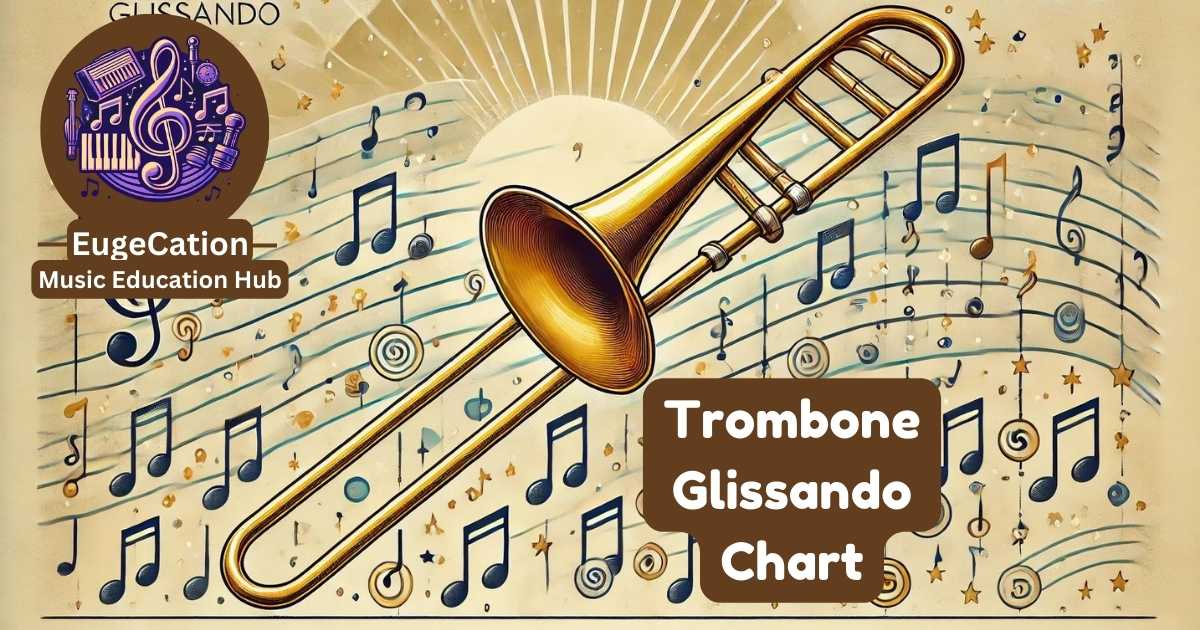
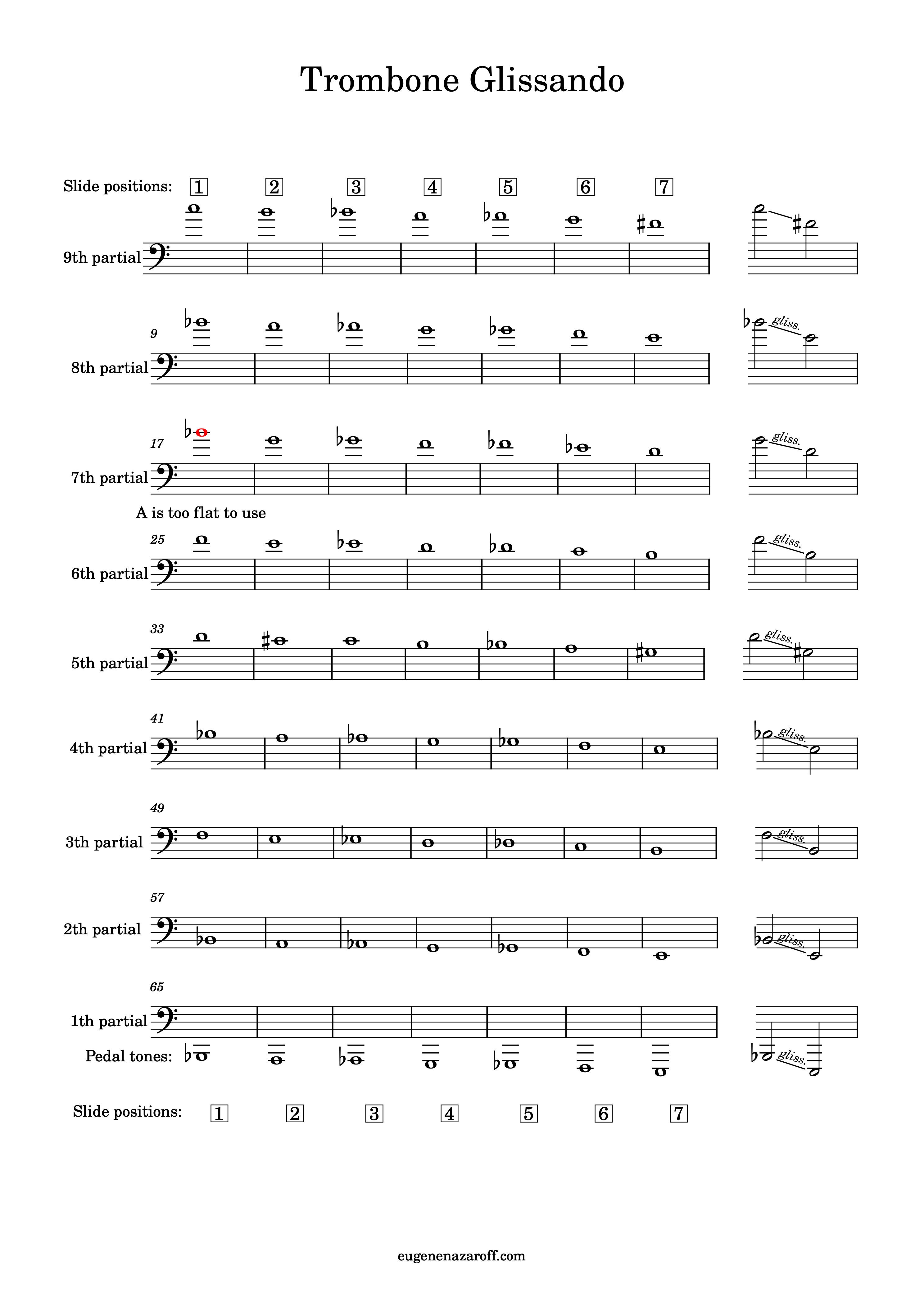
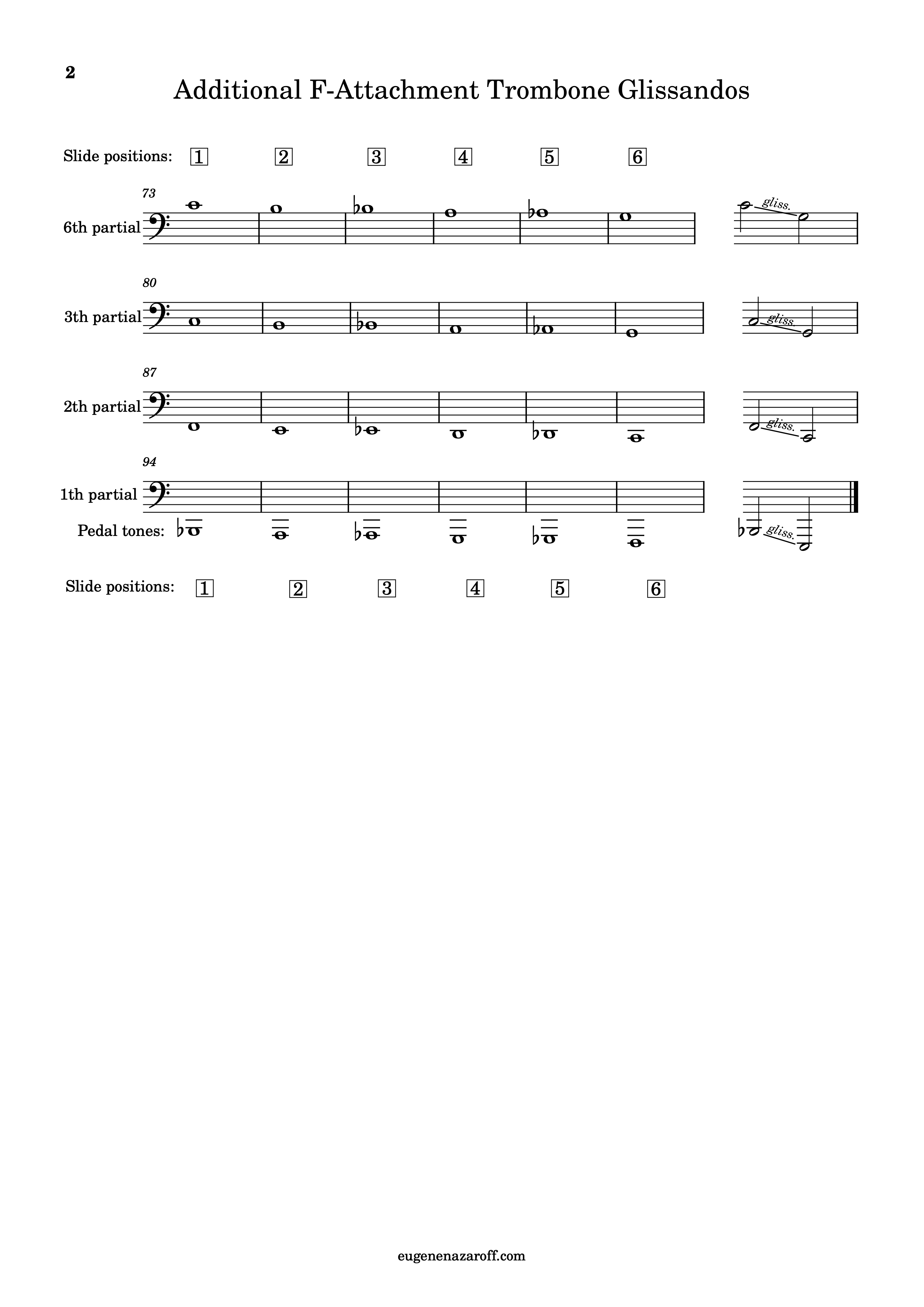
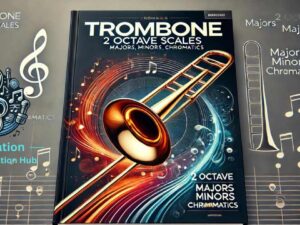



Reviews
There are no reviews yet.